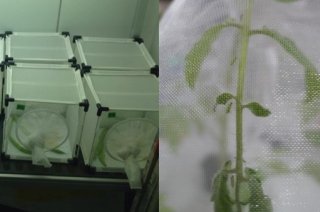
News
Evaluating intraspecific genetic variation for phytophagy in Nesidiocoris tenuis
The use of zoophytophagous predators in crops has increased in the last decade due to the ability of these species to remain in the plants at low prey densities, thus reducing the need of several releases of these biocontrol agents during the production season. Nesidiocoris tenuis is one of these predators widely used in cultivated tomatoes across the Mediterranean basin. It has proven to be successful controlling key pests in tomato, but the damages inflicted by its phytophagy (e.g. necrotic rings in stem, wilting and fruit puncturing) when prey is scarce have prompted research initiatives such as my PhD project. A great deal of my thesis is focused on explaining the mechanisms involved in the damage, to explore breeding possibilities for less phytophagous strains.
ESR update - The use of zoophytophagous predators in crops has increased in the last decade due to the ability of these species to remain in the plants at low prey densities, thus reducing the need of several releases of these biocontrol agents during the production season. Nesidiocoris tenuis is one of these predators widely used in cultivated tomatoes across the Mediterranean basin. It has proven to be successful controlling key pests in tomato, but the damages inflicted by its phytophagy (e.g. necrotic rings in stem, wilting and fruit puncturing) when prey is scarce have prompted research initiatives such as my PhD project. A great deal of my thesis is focused on explaining the mechanisms involved in the damage, to explore breeding possibilities for less phytophagous strains.
With my last experiment I evaluated whether there is genetic variation for phytophagy in a wild population of N. tenuis. Ten isofemale lines were established in the laboratory from individuals collected in an organic tomato field in Valencia, Spain. These lines were reared for 11 generations and kept in identical conditions to control for the environmental influence. Phytophagy was assessed by placing ten adult individuals of each isofemale line and the commercial line on a tomato leaf enclosed in a muslin bag without prey and allowing them to feed on the plant tissue for 5 days. After this time period insects and muslin bags were removed and I proceeded to count number of necrotic rings. And what we got from this experiment is really exciting! Even the initial wild population was small we did find variation in their potential to cause necrotic rings in tomato plants. Three of the isofemale lines showed differences compared to the commercial line, suggesting a big potential to find even more variability among individuals from a more numerous and diverse (i.e. individuals from different countries) initial population. Preliminary calculations of heritability of this trait suggest there is room for future experiments on selection for foraging behavior in N. tenuis, which is not only exciting for my project but also for biological control practitioners who can eventually benefit from breeding technologies!
